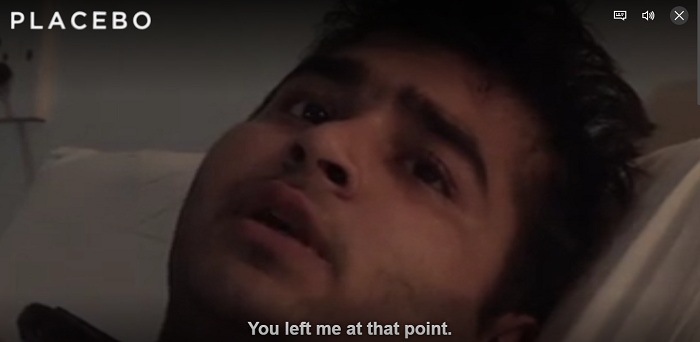Scene on the screen: A twenty-something man is making cutting remarks at his interrogator behind the camera. Through the exchange, the camera is trembling, shaking, and takes a dip as if it were sighing.

The film running was a documentary Mod (2016) in Dharamshala International Film Festival. In the audience was the maker of this film, Pushpa Rawat watching her work with rapt attention. The 2o-something in the scene described above is Ankur, Pushpa’s brother. When I chat with her later, Pushpa said the argument caught on camera transformed her relationship with her brother. Specifically, she said, one curt reply, the English subtitles of which read: “You yell at me and embarrass me in front of my friends.”
Somewhere in her film Pushpa declares that her purpose is “to understand boys”. The protagonists of the documentary are a couple of out-of-work young men who frequent a water tank in her lower-middle class neighbourhood. The young men were in effect a means for Pushpa to understand her own brother, also an unemployed aimless drifter, who like other boys of the infamous water tank has accepted that he is ‘as good as garbage’.
Mod may remind some of Abhay Kumar’s documentary Placebo (2014), which was also showcased in the same festival sometime in 2015. Abhay’s younger brother, Sahil, a medical student, lost fine motor movements in his right hand after he punched a glass pane. The wound is self-inflicted. While Sahil is recovering at home, Abhay embeds himself in Sahil’s hostel, to make sense of the act or to cope with it. Three students open upto him about their secrets and fears. The boys become his protagonists, and a way into the mind and thoughts of the filmmaker’s brother. As a parallel strand, the narrative also unravels the innards of India’s premier medical institute.
Nirnay (2012) trailer
The candid, raw narrative of Mod would have surprised those who have not watched Pushpa’s first documentary, Nirnay (2012), in which Pushpa’s own family and friends come under intense scrutiny. In one sequence that made it to the trailer, the camera focuses on her father: we hear her steady voice questioning him about her own marriage (she wasn’t allowed to marry the man of her choice because of caste differences). Through the camera, we almost feel her gaze boring into her father.
In Pushpa’s films we see a determined woman who is single-mindedly looking for answers. Like Abhay. At times she is so persistent with her questions that she can seem ruthless, even brutal. Like Abhay.
*
In The Shepherdess of the Glaciers (2015), filmmaker Stanzin Dorjai Gya follows his sister Tsering, a shepherdess in a trans-Himalayan valley of Ladakh. The film is paced slow, with stunning imagery, crafted for and with European sensibilities (like his previous three documentaries, Stanzin shares directorial credit with French filmmaker Christiane Mordelet).
The Shepherdess of the Glaciers (2015) trailer
The Shepherdess… does not have the raw energy of familial conflicts and confessions, but look closely, and one can see the film being steered by the relationship the siblings share. Stanzin doesn’t overstep the boundaries of a brother-sister relationship. The filmmaker in him was desperate to ask his protagonist questions about her sexuality, marriage or motherhood. But he doesn’t. “She is my sister,” is all he answered to my persistent “why not”.
The Shepherdess…is not a quest for closure, nor an attempt to make sense of the hand you are dealt with. In fact the idea of the film was given to Stanzin by three European women with whom he had a chance encounter during a train journey in France. It did not need an intense scrutiny, he felt. Any questions that carried the possibility of “corrupting” the sacred familial bonds were left unasked. And so, all we get is a distant glimpse and an incomplete sense of what solitude means for a shepherdess in the Himalayas.
*
An honest family documentary, in a way, has a lot on stake. The characters are your family, the psychodrama is your life. And in the end, you sit with hours of footage, editing it to an “interesting” film for the world to watch. In his limited screen time in Mod, Ankur expressed his resentment at the camera, at him being a character in “the film”. The exposé of her dysfunctional family fills him with a deep sense of shame. “Tum ghar ki badnaami karwana chahti ho? (Do you want to bring disgrace to our family?)” he asked every time the documentary was premiered.
Pushpa herself was caught in the emotional churn she instigated through her filming. Her family’s behaviour was typical and unsurprising to her, but she wasn’t prepared for their accusations and revelations. The camera witnesses her emotional involvement. It slips, twitches, freezes or falls out of focus. Even when switched off, it is always present. It has hammered the walls of the house down, and the whole family, with its weaknesses and vulnerabilities, stands exposed to the world. And there is no going back.
The camera also gives these filmmakers the luxury of distancing themselves from the chaos of their realities. It allows them to step back, investigate, and dig deeper into their relationships, their families and themselves. The camera allows them to ask questions, to counter question. Is it better to keep some truths uncovered, for sake of sanity, I asked Pushpa. She dismissed it with a laugh. Too much truth could be a route to self-annihilation, I add. She nods and whispers yes, then shrugs. For Pushpa, the camera has been a way to accept and to heal, and also to let go.

In Placebo’s most poignant sequence , Sahil blames his brother Abhay for abandoning him when he needed him most. “As an elder brother, it was your responsibility to sit down with me. The talk we are having right now on the camera, it should have been before and after the incident. You should have been at home when I was at home. You were so engrossed in your film that you completely ignored me,” he says. The film at this point acquires parallel identities—a distance between the brothers that increases as the film progresses, a testimony of their transformed relationship, and evidence of the filmmaker’s “selfish” obsession. A few minutes later into the film, Sahil tells his older brother, “Sadly, I don’t think I know you now. Even to trust you, I had to force myself.” The film was received standing ovation and thunderous claps from the audiences world over.
**
A version of this article was first published in the Indian Quarterly.

